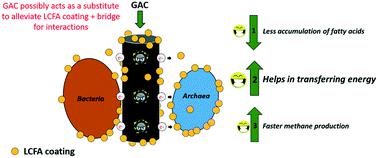当前位置:
X-MOL 学术
›
Environ. Sci.: Water Res. Technol.
›
论文详情
Our official English website, www.x-mol.net, welcomes your
feedback! (Note: you will need to create a separate account there.)
Addition of granular activated carbon during anaerobic oleate degradation overcomes inhibition and promotes methanogenic activity
Environmental Science: Water Research & Technology ( IF 3.5 ) Pub Date : 2021-2-16 , DOI: 10.1039/d0ew01093f Lea Chua Tan 1, 2, 3 , Piet N. L. Lens 1, 2, 3
Environmental Science: Water Research & Technology ( IF 3.5 ) Pub Date : 2021-2-16 , DOI: 10.1039/d0ew01093f Lea Chua Tan 1, 2, 3 , Piet N. L. Lens 1, 2, 3
Affiliation

|
This study aimed to elucidate the mechanism of how GAC improves oleate degradation by comparing the degradation profile and microbial community changes from granular activated carbon (pellet GAC, rod shape, 0.8 × 3.0 mm) supplemented assays with various control assays, including non-conductive materials using silica beads and pumice stone. Addition of GAC showed on average an 164% decrease in lag-phase duration compared to no-GAC addition leading to quicker methane generation. In addition, when 2-bromoethanesulfonate was added to inhibit methanogens, LCFA degradation of oleate to palmitate, then further to acetate was 50% faster in GAC-amended conditions. Control assays showed no improvement in degradation profiles or methane generation. Changing the GAC particle sizes showed smaller particle sizes drastically shortening the lag-phase duration compared to larger particle sizes. Scanning electron microscopic imaging of GAC revealed promotion of biofilm growth with evidence of pili-like structures on its surface, while non-conductive materials did not. DNA microbial community analysis revealed similar relative abundance in the suspension for control assays and GAC-supplemented bottles with the dominant bacterial families Clostridiaceae (41 ± 6%) and Synergistaceae (30 ± 4%) and the archaea family Methanomicrobiaceae (61 ± 10%). On the other hand, the DNA microbial community from the GAC biofilm revealed a higher relative abundance of Geobacteraceae at 9%, compared to <2% from the inoculum and control assay suspensions, and Methanosaetaceae at 78%. Overall, this study revealed that the conductive property of GAC is likely the main driver for the improved AD process by promoting the growth of electroactive microorganisms and direct interspecies electron transfer process.
中文翻译:

在厌氧油酸酯降解过程中添加颗粒状活性炭可克服抑制作用并促进产甲烷活性
这项研究旨在通过比较补充活性的颗粒状活性炭(小球状GAC,棒状,0.8×3.0 mm)的降解曲线和微生物群落变化,阐明GAC如何改善油酸盐降解的机理,包括各种非导电材料使用二氧化硅珠和浮石。与未添加GAC相比,添加GAC显示平均滞后时间减少了164%,从而可更快地生成甲烷。另外,当加入2-溴乙烷磺酸盐以抑制产甲烷菌时,在GAC修正的条件下,LCFA将油酸酯的LCFA降解为棕榈酸酯,然后进一步降解为乙酸酯。对照试验显示降解曲线或甲烷生成没有改善。更改GAC粒度显示,与较大的粒度相比,较小的粒度会大大缩短滞后阶段的持续时间。GAC的扫描电子显微镜成像显示出生物膜生长的促进,并在其表面形成了菌丝状结构,而非导电材料则没有。DNA微生物群落分析显示,在悬浮液中的相对丰度相似,用于对照测定和带有优势细菌家族的GAC补充瓶梭菌科(41±6%)和增效菌科(30±4%)和古细菌家族的甲烷微菌科(61±10%)。在另一方面,从GAC生物膜的DNA的微生物群落揭示的较高的相对丰度Geobacteraceae在9%,比<2%的接种和对照测定悬浮液,以及Methanosaetaceae在78%。总体而言,这项研究表明,GAC的导电特性可能是通过促进电活性微生物的生长和直接种间电子转移过程来改善AD过程的主要驱动力。
更新日期:2021-02-22
中文翻译:

在厌氧油酸酯降解过程中添加颗粒状活性炭可克服抑制作用并促进产甲烷活性
这项研究旨在通过比较补充活性的颗粒状活性炭(小球状GAC,棒状,0.8×3.0 mm)的降解曲线和微生物群落变化,阐明GAC如何改善油酸盐降解的机理,包括各种非导电材料使用二氧化硅珠和浮石。与未添加GAC相比,添加GAC显示平均滞后时间减少了164%,从而可更快地生成甲烷。另外,当加入2-溴乙烷磺酸盐以抑制产甲烷菌时,在GAC修正的条件下,LCFA将油酸酯的LCFA降解为棕榈酸酯,然后进一步降解为乙酸酯。对照试验显示降解曲线或甲烷生成没有改善。更改GAC粒度显示,与较大的粒度相比,较小的粒度会大大缩短滞后阶段的持续时间。GAC的扫描电子显微镜成像显示出生物膜生长的促进,并在其表面形成了菌丝状结构,而非导电材料则没有。DNA微生物群落分析显示,在悬浮液中的相对丰度相似,用于对照测定和带有优势细菌家族的GAC补充瓶梭菌科(41±6%)和增效菌科(30±4%)和古细菌家族的甲烷微菌科(61±10%)。在另一方面,从GAC生物膜的DNA的微生物群落揭示的较高的相对丰度Geobacteraceae在9%,比<2%的接种和对照测定悬浮液,以及Methanosaetaceae在78%。总体而言,这项研究表明,GAC的导电特性可能是通过促进电活性微生物的生长和直接种间电子转移过程来改善AD过程的主要驱动力。











































 京公网安备 11010802027423号
京公网安备 11010802027423号